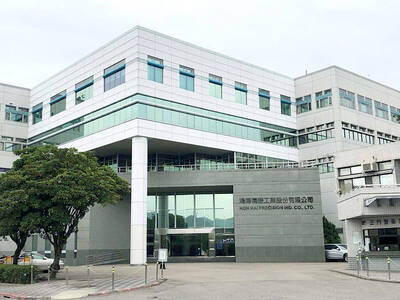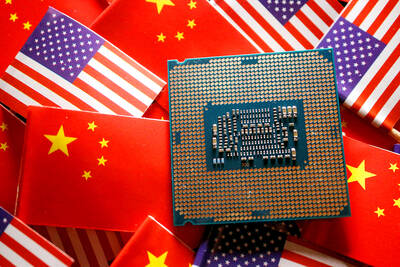From Brasilia to Seoul, finance ministers are obsessing over the US dollar. Its decline could have great impact on the global financial system.
Yet rather than asking Secretary of the Treasury John Snow if the US still favors a "strong dollar," officials should look to Asia.
Regardless of where US President George W. Bush administration wants the dollar to go, Asians have co-opted the strong-dollar policy -- and they aren't about to let go of it.
The US, meanwhile, has stolen Asia's devalue-your-way-to-growth tactic. While Snow isn't saying so, the US seems quite happy with the dollar's 10 percent drop against the yen and nearly 16 percent drop versus the euro during the past year.
All this policy co-opting amounts to a risky tug of war over the dollar.
So long as its decline is orderly, the US is happy to see exports become cheaper. But Asian central banks are stepping up dollar sales to pull the dollar the other way, fearing stronger currencies will slam growth.
Who will win this tug of war? It's anyone's guess, but the fact it's taking place offers a couple of hints about the global economic outlook.
For one thing, a dollar crisis probably won't come as soon as feared. Asian central banks, already voracious buyers of US Treasuries, would merely increase purchases to stabilize the dollar. Asia isn't known for cooperating on region-wide polices, but it agrees a weaker dollar isn't an option.
For another, a necessary adjustment in global markets is being delayed.
Even those in the deficits-don't-matter camp must wonder how long the US can live this far beyond its means. The record budget deficit is one thing, but the gaping current account deficit is a clear and present danger.
The current account deficit is more than 5 percent of GDP, a record. Unless the dollar weakens, it will continue widening, making the imbalance bigger and more dangerous as well.
It would help if Asia just left the dollar alone.
For all the good news in the region -- surging equities, booming growth and emerging middle classes -- it's stuck in a developing-nation mentality. It has been almost a decade since a rebound in Asia coincided with a global one. That, coupled with improving domestic demand, means this Asian recovery is on reasonably solid footing.
It's not just China, which grew an astounding 9.9 percent in the fourth quarter from a year earlier. Thailand and Vietnam are booming, and Hong Kong, Malaysia, Singapore and Taiwan are confounding skeptics.
South Korea, no longer in recession, is expected to grow 3 percent this year. Even deflation-plagued Japan is on the mend after 13 years in and out of recession.
While big challenges and risks remain, Asians are less concerned about a huge banking crisis in their biggest economy.
It stands to reason, then, that traders are bidding up Asian currencies. If governments are to be taken at their word -- that exchange rates should reflect economic fundamentals -- currencies should rise. Yet an exorbitant amount of time and energy still goes into holding down exchange rates.
This obsession is ironic given the dollar's role in the 1997 Asian crisis. During the 1990s, the US hogged a greater share of capital than it deserved. By acting like a huge magnet, the dollar-buying boom deprived economies like Indonesia, South Korea and Thailand of much needed investment.
It also led to risky imbalances. One was allowing an already huge US trade imbalance to widen. Another was attracting mountains of capital from Japan by way of the so-called ``yen-carry trade.'' Negligible interest rates in Japan had investors borrowing cheaply in yen and reinvesting the money in higher-returning assets like US Treasuries. Many still employ the trade.
Asians would love to see the dollar return to its mid-1990s heights. Yet efforts to boost it are leading to new asset bubbles.
The Bank of Japan alone sold a record ?20.1 trillion(US$198 billion) last year, buying US Treasuries with the proceeds. It pushed some US rates down to Japan-like levels -- US two-year notes now yield 1.60 percent.
The biggest irony is that the US could win either way at Asia's expense. If Asia lets the dollar drop, US exports and growth will get a boost and the current account bubble will narrow. If Asia continues boosting the dollar and buying Treasuries, US interest rates stay low and the US can fund ever-bigger deficits.
The former outcome would be better for Asia. While it bristles at the idea of the world's largest economy devaluing its way to prosperity, Asia's fortunes are closely tied to the US If US growth booms and consumers buy more Asian goods, wouldn't it be worth the short-term pain of stronger local currencies?
It's an end-justifies-the-means situation for Asia. The region's preoccupation with weak currencies makes little sense in the short run and even less in the long run.
All the more reason for Asia to reconsider its tug of war with Washington.

Shares in Taiwan closed at a new high yesterday, the first trading day of the new year, as contract chipmaker Taiwan Semiconductor Manufacturing Co (TSMC, 台積電) continued to break records amid an artificial intelligence (AI) boom, dealers said. The TAIEX closed up 386.21 points, or 1.33 percent, at 29,349.81, with turnover totaling NT$648.844 billion (US$20.65 billion). “Judging from a stronger Taiwan dollar against the US dollar, I think foreign institutional investors returned from the holidays and brought funds into the local market,” Concord Securities Co (康和證券) analyst Kerry Huang (黃志祺) said. “Foreign investors just rebuilt their positions with TSMC as their top target,

REVENUE PERFORMANCE: Cloud and network products, and electronic components saw strong increases, while smart consumer electronics and computing products fell Hon Hai Precision Industry Co (鴻海精密) yesterday posted 26.51 percent quarterly growth in revenue for last quarter to NT$2.6 trillion (US$82.44 billion), the strongest on record for the period and above expectations, but the company forecast a slight revenue dip this quarter due to seasonal factors. On an annual basis, revenue last quarter grew 22.07 percent, the company said. Analysts on average estimated about NT$2.4 trillion increase. Hon Hai, which assembles servers for Nvidia Corp and iPhones for Apple Inc, is expanding its capacity in the US, adding artificial intelligence (AI) server production in Wisconsin and Texas, where it operates established campuses. This

H200 CHIPS: A source said that Nvidia has asked the Taiwanese company to begin production of additional chips and work is expected to start in the second quarter Nvidia Corp is scrambling to meet demand for its H200 artificial intelligence (AI) chips from Chinese technology companies and has approached contract manufacturer Taiwan Semiconductor Manufacturing Co (TSMC, 台積電) to ramp up production, sources said. Chinese technology companies have placed orders for more than 2 million H200 chips for this year, while Nvidia holds just 700,000 units in stock, two of the people said. The exact additional volume Nvidia intends to order from TSMC remains unclear, they said. A third source said that Nvidia has asked TSMC to begin production of the additional chips and work is expected to start in the second

US President Donald Trump on Friday blocked US photonics firm HieFo Corp’s US$3 million acquisition of assets in New Jersey-based aerospace and defense specialist Emcore Corp, citing national security and China-related concerns. In an order released by the White House, Trump said HieFo was “controlled by a citizen of the People’s Republic of China” and that its 2024 acquisition of Emcore’s businesses led the US president to believe that it might “take action that threatens to impair the national security of the United States.” The order did not name the person or detail Trump’s concerns. “The Transaction is hereby prohibited,”